Qin Dynasty 221 - 207 BC
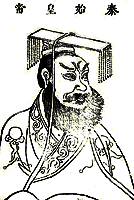
Emperor Qin Shi Huangdi |
|
About the Qin
Emperor Qin Shi Huangdi was the first emperor to unite China. He did this not only through force, but also by standardizing systems throughout the country such as currency, writing, weights and measurements. His policies were strict and many nobles and scholars disliked them. He put 460 scholars to death as a warning to those who considered opposing them. His most infamous act was the "burning of the books " in 213 BC. As a result, many important writings from ancient China were lost. Fortunately some texts on divination,
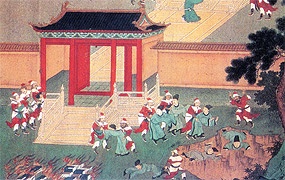 |
| Burning books and burying scholars alive |
medicine and agriculture were saved. Eventually his empire fell apart with the uprising of the peasants that led to the founding of the Han Dynasty. |
Han Dynasty 206 BC - 220 AD
* Western Han 206 BC 24 AD 24 AD
* Eastern Han 25 220 AD 220 AD
About the Han
Liu Bang launched the Han Dynasty in 206 BC and adopted the systems and harsh laws initially put in place by Emperor of the Qin Dynasty. During the years of 9 to 23 AD, Wang Man founded a new dynasty called the Xin, which marked a break between the Western and Eastern Han. However, his reign was short lived and in 23 AD a rebel peasant army, the Red Eyebrows put Wang Mang to death signaling the beginning of the Eastern Han Dynasty.
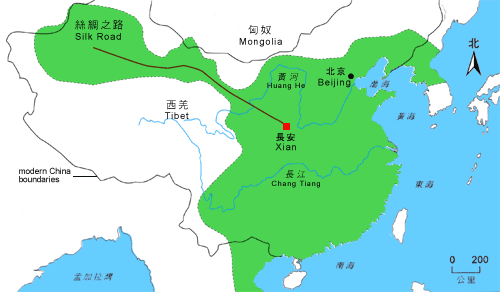 |
| Expanded empire of Western Han Dynasty |
During this period, nomadic tribes were constantly invading China. As a result the Western Han Dynasty expanded its empire into what is today known as Mongolia, Manchuria, Korea, South China, Vietnam, and Central Asia. The Silk Road in Northwest China was a popular communication and trade route. The Han dynasty was also a time of innovation with vast developments in the arts, philosophy and technology. For example, Zang Heng (78 139AD), a scientist and astronomer, invented the first seismograph in the 2nd century. 139AD), a scientist and astronomer, invented the first seismograph in the 2nd century.
The Role of Philosophy and Religion
Philosophy, societal values and religion played key roles in shaping the practice of Chinese medicine. Many sects and religions including Buddhism were introduced or already well-established by this time. In addition, books that examined ancient Chinese history made their appearance. One of the famous examples was Sima Qian (c. 145 85 BC), who finished the classic Shi Ji (The Historical Records) which detailed China's history from the earliest times to his own day. This set a standard for all subsequent Chinese historical writing. The quality of medical writings also improved as more medical texts were being written. 85 BC), who finished the classic Shi Ji (The Historical Records) which detailed China's history from the earliest times to his own day. This set a standard for all subsequent Chinese historical writing. The quality of medical writings also improved as more medical texts were being written.
 |
| Confucius and his disciples, the sage's disciples played a decisive role in spreading his teachings. |
Due to the vast adoption of Confucian beliefs, most children took care of their parents when they were ill because this was considered the family members' responsibility. Consequently, many scholars and academics studied medical writings so they could perform the functions of a doctor should a doctor be unavailable. This led to an influx of philosophical thinking in the practice of Chinese medicine.
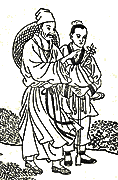
Searching for herbs |
Taoism and Immortality
One popular Taoist concept was that of longevity. Many emperors sought out herbs or elixirs that could make them immortal. Other religions such as Buddhism also aimed to discover the secrets of Shangri-la by turning to Taoism. For example, Emperor Lingdi (168 189 AD) of the Han Dynasty invited Buddhist monks of another Taoist sect from India to his court in hopes that they would be able to provide him the elixir of immortality. These immortality elixirs were the origins of Chinese prescriptions. 189 AD) of the Han Dynasty invited Buddhist monks of another Taoist sect from India to his court in hopes that they would be able to provide him the elixir of immortality. These immortality elixirs were the origins of Chinese prescriptions.
Development of Medical System and Education
Apprenticeships were a common means of educating new physicians in the Western Han Dynasties. These apprenticeships were mostly handed down through families because this insured a steady and reliable income. The prestige of the doctor was based on how many generations the family had been practicing medicine. In fact, one medical book from that period warned against taking medication from a physician if his family had been practicing medicine for less than three generations. The selection of apprentices was a stringent process. Even the Huang Di Nei Jing (The Yellow Emperor's Classic of Internal Medicine) emphasized a careful selection of the apprentice since his success would bring the master fame. Other ways of becoming a doctor included studying prescriptions made by other doctors in a pharmacy or by self-study of medicine.
Examinations to recruit qualified physicians were introduced during the Han Dynasty. Emperor Yuan in 43 BC required all his attendant officials who were doctors to be tested. Interestingly, this examination was not necessarily based on medical knowledge, but rather the ability to be "simple in life, honest in dealings, polite in social intercourse, and good in conduct."
Basic medical service on a national level was also introduced during this dynasty. Physicians were divided into two groups. There were the imperial court physicians who attended to the emperor, and the physicians who attended to the army and the common people within the provinces of the empire.
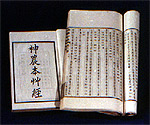 |
| Shennong Bencaojing (Classic of Herbal Medicine) |
Shennong Bencaojing (Classic of Herbal Medicine)
One of the most important medical books to come out of the Han Dynasty was the Shennong Bencaojing (Classic of Herbal Medicine). The word bencao means "essential herb". While its attributed author is the Fire Emperor discussed earlier, no one knows for sure who wrote it. What is known is that it was written between the 1st and 2nd century BC, and is considered to be the earliest complete Chinese pharmacopoeia reference.
This book lists a total of 365 Chinese medicines from which 252 were of plant origin, 67 from animals, and 46 from minerals. Each medicine was divided into one of three categories. The superior category included 120 medicines, which were considered to be non-toxic and contain invigorating effects to preserve vitality or prolong life. One of the most famous herbs in this category is ginseng (Panax ginseng). The second category included average medicines of which 120 were listed. Medicines in this category were used to prevent illness and restore the individual's vitality. However, the medicines listed here containing herbs such as Chinese angelica (Angelica sinensis) and ephedra (mahuang) could sometimes be toxic and should be used carefully for certain ailments. The third category included 125 inferior medicines that were considered to be toxic with side effects, and were specifically used for therapeutic purposes to treat diseases. Croton (Croton tiglium) is an example of an herb in this category which helps to relax the bowels, relieve edema (swelling) or eliminate phlegm evils.
| Ginseng |
Chinese angelica |
Ephedra |
Croton tiglium |
| Superior category |
The second category |
The third category |
Prominent Physicians of the Han Dynasty
During the Han Dynasty several prominent physicians emerged. Chunyu Yi (215 167 BC) was the first doctor to keep "medical records" on the patients he treated. Guo Yu, who was the court physician of Emperor He, and Fu Weng were two doctors of the first century AD who were renowned for their skills in acupuncture and moxibustion. 167 BC) was the first doctor to keep "medical records" on the patients he treated. Guo Yu, who was the court physician of Emperor He, and Fu Weng were two doctors of the first century AD who were renowned for their skills in acupuncture and moxibustion.
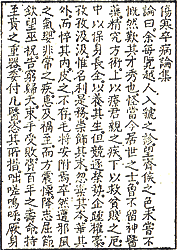 |
| A copy from Shanghan zabzabinglun (Discourse on Fevers and Miscellaneous Illnesses) |
Zhang Zhongjing also known as Zhang Ji (150 219 AD) was considered to be a 'sage of medicine.' He penned a book called Shanghan Zabinglun (Discourse on Fevers and Miscellaneous Illnesses), which dealt with the treatment of many febrile conditions. The book contains six parts, which correspond to the six pairs of meridians. It is significant because it discusses diagnosis and treatment methods based on an assessment of the symptoms of different pathological conditions. Later in the Song dynasty (960 219 AD) was considered to be a 'sage of medicine.' He penned a book called Shanghan Zabinglun (Discourse on Fevers and Miscellaneous Illnesses), which dealt with the treatment of many febrile conditions. The book contains six parts, which correspond to the six pairs of meridians. It is significant because it discusses diagnosis and treatment methods based on an assessment of the symptoms of different pathological conditions. Later in the Song dynasty (960 1279AD), his book was rewritten and divided into two books called Shanghanlun (Treatise on Febrile Diseases) and Jinkui Yaolue (Summary from the Golden Chest). 1279AD), his book was rewritten and divided into two books called Shanghanlun (Treatise on Febrile Diseases) and Jinkui Yaolue (Summary from the Golden Chest).
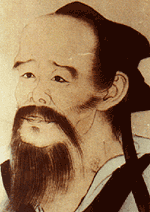
Hua Tuo |
Hua Tuo (141 208 AD) was a contemporary of Zhang Zhongjing. He traveled from town to town treating patients and learning from other doctor's practices. He is famous for his skill as a surgeon and his use of anesthesia. The anesthesia was given as a powder called mafeisan that was dissolved in a fermented drink before performing surgery. It has been suggested the powder may have been hemp since its uses were unknown at that time. Besides performing surgeries, Hua Tuo also recommended the use of physical exercises for his patients. He devised movements that were similar to the movements of five different animals. These were the tiger, deer, bear, monkey and bird. It is said that one of his disciples Wu Pu lived to be 90-years-old due to these exercises. Another of Hua Tuo's disciples called Fan A was a great acupuncturist. He devised methods to extend it use to the back and thorax. Unfortunately many of Hua Tuo's works have been lost, and surgery became unpopular because most Chinese beliefs and laws of the time did not look favorably on it. 208 AD) was a contemporary of Zhang Zhongjing. He traveled from town to town treating patients and learning from other doctor's practices. He is famous for his skill as a surgeon and his use of anesthesia. The anesthesia was given as a powder called mafeisan that was dissolved in a fermented drink before performing surgery. It has been suggested the powder may have been hemp since its uses were unknown at that time. Besides performing surgeries, Hua Tuo also recommended the use of physical exercises for his patients. He devised movements that were similar to the movements of five different animals. These were the tiger, deer, bear, monkey and bird. It is said that one of his disciples Wu Pu lived to be 90-years-old due to these exercises. Another of Hua Tuo's disciples called Fan A was a great acupuncturist. He devised methods to extend it use to the back and thorax. Unfortunately many of Hua Tuo's works have been lost, and surgery became unpopular because most Chinese beliefs and laws of the time did not look favorably on it.
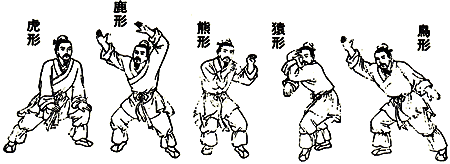
Physical exercises - tiger, deer, bear, monkey and bird movements. |
Dong Feng was another well-known physician who practiced towards the end of the Han Dynasty during the reign of Emperor Xian.
The end of the Han Dynasty
In 184 AD, the Yellow Turbans successfully broke up the Han Dynasty. The army generals held the real power and this led to the Three Kingdoms period of the 3rd century AD. One general called Cao Cao was especially militant. He has requested Hua Tuo to remain in his service after being treated for a migraine headache. After Hua Tuo refused, Cao Cao had him killed.
|